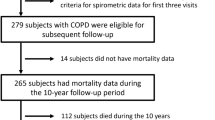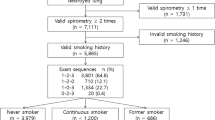Abstract
Background
The progression of lung hyperinflation in patients with chronic obstructive pulmonary disease (COPD) has not been studied in a long-term prospective cohort. We explored the longitudinal changes in lung volume compartments with the aim of identifying predictors of a rapid decline of the inspiratory capacity to total lung capacity ratio (IC/TLC).
Methods
The study population comprised 324 patients with COPD who were recruited prospectively. Annual rates of changes in pulmonary function, including forced expiratory volume in 1 s (FEV1), forced vital capacity (FVC), total lung capacity (TLC), functional residual capacity (FRC), residual volume (RV), vital capacity (VC), IC, and IC/TLC, were estimated using the random coefficient models.
Results
The mean annual rates of changes in pre- and post-bronchodilator FEV1 were −23.0 mL/year (p < 0.001) and −26.5 mL/year (p = 0.004). The mean annual rates of changes in VC, IC, TLC, and IC/TLC were −33.7 mL/year (p = 0.007), −53.9 mL/year (p < 0.001), −43.7 mL/year (p = 0.012), and −0.65 %/year (p = 0.001), respectively. RV, FRC, and RV/TLC did not change significantly during the study period. Multivariate logistic regression analysis showed that a high modified Medical Research Council (MMRC) dyspnea scale score, a high Charlson comorbidity index value, and low post-bronchodilator FEV1 were associated with rapid decline in IC/TLC.
Conclusion
MMRC dyspnea scale, post-bronchodilator FEV1, and the Charlson comorbidity index at baseline were independent predictors of a rapid decline in IC/TLC.

Similar content being viewed by others
References
Rabe KF, Hurd S, Anzueto A, Barnes PJ, Buist SA, Calverley P, Eukuchi Y, Jenkins C, Rodriguez-Roisin R, van Weel C, Zielinski J (2007) Global strategy for the diagnosis, management, and prevention of chronic obstructive pulmonary disease: GOLD executive summary. Am J Respir Crit Care Med 176(6):532–535
Thomason MJ, Strachan DP (2000) Which spirometric indices best predict subsequent death from chronic obstructive pulmonary disease? Thorax 55:785–788
Mahler DA, Harver A (1992) A factor analysis of dyspnea ratings, respiratory muscle strength, and lung function in patients with chronic respiratory obstructive pulmonary disease. Am Rev Respir Dis 145:467–470
Jones PW (2001) Health status measurement in chronic obstructive pulmonary disease. Thorax 56:880–887
Cooper CB (2006) The connection between chronic obstructive pulmonary disease symptoms and hyperinflation and its impact on exercise and function. Am J Med 119:S21–S31
O’Donnell DE, Lam M, Webb KA (1999) Spirometric correlates of improvement in exercise performance after anticholinergic therapy in chronic obstructive pulmonary disease. Am J Respir Crit Care Med 160:542–549
O’Donnell DE, Laveneziana P (2006) Physiology and consequence of lung hyperinflation in COPD. Eur Respir Rev 15:61–67
Casanova C, Cote C, de Torres JP, Aguirre-Jaime A, Marin JM, Pinto-Plata V, Celli BR (2005) Inspiratory-to-total lung capacity ratio predicts mortality in patients with chronic obstructive pulmonary disease. Am J Respir Crit Care Med 171:591–597
Vestbo J, Edwards LD, Scanlon PD, Yates JC, Agusti A, Bakke P, Calverley PM, Celli B, Coxson HO, Crim C, Lomas DA, MacNee W, Miller BE, Silverman EK, Tal-Singer R, Wouters E, Rennard SI, ECLIPSE Investigators (2011) Changes in forced expiratory volume in 1 s over time in COPD. N Engl J Med 365:1184–1192
Leith DE, Brown R (1999) Human lung volumes and the mechanisms that set them. Eur Respir J 13:468–472
Lee YK, Oh YM, Lee JH, Kim EK, Lee JH, Kim NK, Seo JB, Lee SD, KOLD Study Group (2008) Quantitative assessment of emphysema, air trapping, and airway thickening on computed tomography. Lung 186(3):157–165
Anon (1959) Terminology, definitions, and classification of chronic pulmonary emphysema and related conditions. A report of the conclusions of a Ciba guest symposium. Thorax 14:286–299
Lee JS, Ra SW, Chae EJ, Seo JB, Lim SY, Kim TH, Lee SD, Oh YM (2011) Validation of the lower limit of normal diffusing capacity for detecting emphysema. Respiration 81:287–293
Gevenois P, de Maertelaer V, De Vuyst P, Zanen J, Vernault JC (1995) Comparison of computed density and macroscopic morphometry in pulmonary emphysema. Am J Respir Crit Care Med 152(2):653–657
Wanger J, Clausen JL, Coates A, Pedersen OF, Brusasco V, Burgos F, Casaburi R, Crapo R, Enright P, van der Grinten CP, Gustafsson P, Hankinson J, Jensen R, Johnson D, MacIntyre N, Mckay R, Miller MR, Navajas D, Pellegrino R, Viegi G (2005) Standardisation of the measurement of lung volumes. Eur Respir J 26:511–522
Casanova C, de Torres JP, Aguirre-Jaime A, Pinto-Plata V, Marin JM, Cordoba E, Baz R, Cote C, Celli BR (2011) The progression of chronic obstructive pulmonary disease is heterogeneous: The experience of the BODE cohort. Am J Respir Crit Care Med 184:1015–1021
Pellegrino R, Brusasco V (1997) On the causes of lung hyperinflation during bronchoconstriction. Eur Repir J 10:468–475
Rochester DF (1984) The respiratory muscles in COPD: state of the art. Chest 85(6 suppl):47S–50S
Oroaco-Levi M (2003) Structure and function of the respiratory muscles in patients with COPD: impairment or adaptation? Eur Respir J 22:41s–51s
Duranti R, Filippelli M, Bianchi R, Romagnoli I, Pellegrino R, Brusasco V, Scano G (2002) Inspiratory capacity and decrease in lung hyperinflation with albuterol in COPD. Chest 122:2009–2014
Yan S, Kaminski D, Sliwinski P (1997) Reliability of inspiratory capacity for estimating end-expiratory lung volume changes during exercise in patients with chronic obstructive pulmonary disease. Am J Respir Crit Care Med 156:55–59
Newton MF, O’Donnell DE, Forkert L (2002) Response of lung volumes to inhaled salbutamol in a large population of patients with severe hyperinflation. Chest 121:1050–1402
Celli B, ZuWallack R, Wang S, Kesten S (2003) Improvement in resting inspiratory capacity and hyperinflation with tiotropium in COPD patients with increased static lung volumes. Chest 124:1743–1748
Celli BR, Decramer M, Lystig, Kesten S, Tashkin DP (2012) Longitudinal inspiratory capacity changes in chronic obstructive pulmonary disease. Respir Res 13:66
Tashkin DP, Celli B, Senn S, Burkhart D, Kesten S, Menjoge S, Decramer M, for the UPLIFT Study Investigators (2008) New Engl J Med 359:1543–1554
Celli BR, Thomas NE, Anderson JA, Ferguson GT, Jenkins CR, Jones PW, Vestbo J, Knobil K, Yates JC, Calverley PM (2008) Effect of pharmacotherapy on rate of decline of lung function in chronic obstructive pulmonary disease: results from the TORCH study. Am J Respir Crit Care Med 178:332–338
Cazzola M, MacNee W, Martinez FJ, Rabe KF, Franciosi LG, Barnes PJ, Brusasco V, Gurge PS, Calverley PMA, Celli BR, Jones PW, Mahler DA, Make B, Miravitlles M, Page CP, Palange P, Parr D, Pistolesi M, Rennard SI, Rutten-van Molken MP, Stockely R, Sullivan SD, Wedzicha JA, Wouters EF (2008) Outcomes for COPD pharmacological trials: from lung function to biomarkers. Eur Respir J 31(2):416–469
Nishimura M, Makita H, Nagai K, Konno S, Nasuhara Y, Hasegawa M, Shimizu K, Betsuyaku T, Ito YM, Fuke S, Igarashi T, Akiyama Y, Ogura S (2012) Annual change in pulmonary function and clinical phenotype in chronic obstructive pulmonary disease. Am J Respir Crit Care Med 185:44–52
Anthonisen NR, Connett JE, Murray RP (2002) Smoking and lung function of lung health study participants after 11 years. Am J Respir Crit Care Med 166:675–679
de Torres JP, Casanova C, Hernandez C, Abreu J, Aquirre-Jaime A, Celli BR (2006) Gender and COPD in patients attending a pulmonary clinic. Chest 128:2012–2016
Acknowledgments
This study was supported by Grants from the Korea Healthcare Technology R&D Project, Ministry for Health and Welfare Affairs, Republic of Korea (A102065).
Conflict of interest
Y. M. Oh has been an investigator in university-sponsored studies (Asan Institute for Life Science, University of Ulsan College of Medicine) and an industry-sponsored study (MSD Korea and AstraZeneca Korea) and has participated as a speaker at scientific meetings organized and financed by various pharmaceutical companies (Handok, GlaxoSmithKline, AstraZeneca Korea, MSD Korea, and Boehringer Ingelheim) and a magazine company (Korea Doctors’ Weekly). S. D. Lee serves as a consultant to GlaxoSmithKline and has participated as a speaker at scientific meetings organized and financed by various pharmaceutical companies (GlaxoSmithKline, AstraZeneca Korea, and Boehringer Ingelheim). J. S. Lee, S. O. Kim, K. H. Yoo, J. H. Lee, E. K. Kim, Y. K. Lee, T. H. Kim, W. J. Kim, J. H. Lee, S. M. Lee, S. Y. Lee, S. Y. Lim, T. R. Shin, H. I. Yoon, C. K. Rhee, S. W. Lee, and J. W. Huh have no conflicts of interest to disclose.
Author information
Authors and Affiliations
Corresponding author
Additional information
S.-D. Lee and Y.-M. Oh contributed equally to this study.
Rights and permissions
About this article
Cite this article
Lee, J.S., Kim, S.O., Seo, J.B. et al. Longitudinal Lung Volume Changes in Patients with Chronic Obstructive Pulmonary Disease. Lung 191, 405–412 (2013). https://doi.org/10.1007/s00408-013-9478-0
Received:
Accepted:
Published:
Issue Date:
DOI: https://doi.org/10.1007/s00408-013-9478-0




